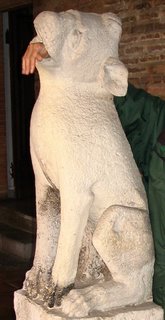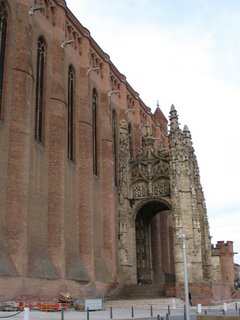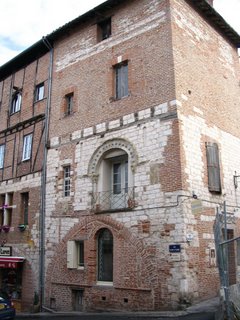This morning the atmosphere was sodden wet and the rain was still falling! That we have managed to stay warm and dry in Modestine really is a credit to her manufacturers. We have remained comfortable every night too, though have welcomed the electricity morning and evening to top up our heating and boil water.
We left Andy and Celia around 9.30am, following the fast, straight, almost deserted Route Nationale 124 through the edge of the Landes towards Toulouse. The countryside is actually very pleasant but as it stretches unchanged for hundreds of kilometres north, it has the reputation of being very boring and monotonous. Our route skirted the edge and we found the pines, bracken and straight roads very enjoyable, even in the rain. Because of the flatness of the area, although we have never seen any, we understand the shepherds hereabouts wear stilts so they can more easily survey their sheep across the flat lands of Gascony.
One common feature of the roads we have found down in the south, is the beautiful, wide avenues of plane trees that flank the main routes as you approach the towns and villages. At this time of year they are leafless but their solid, aged, grey-white trunks are really attractive and quintessentially French. During the summer, with sunlight shining between them and welcome shade overhead, they must be quite magnificent. However, some French drivers have developed the habit of wrapping themselves around them and rather than suggest that drivers could take more care, the government is said to have proposed a cull of all these wonderful trees. This would be a devastating loss to the French landscape but fortunately environmental lobbyists seem to have fought the proposal as we notice that in many places now, metal barricades, similar to those on the central reservation of motorways, have been constructed to protect drivers from these savage trees.
We stopped, by chance, for lunch at Nogaro, an attractive little town that does not even merit a mention in our guidebooks. It was though, a very pleasant place with a really lovely golden sandstone Romanesque church with delightful rounded arches and ornate capitals. The interior walls had 13th century frescoes of the life of St. Lawrence. The town appears to have some importance for the production of Armagnac, which, as we think we mentioned in this blog back in August somewhere, is brandy produced from plums. This area, the Gers, seems to be a centre for growing plums as the major town of Agen is nearby and it is probably the prune capital of Europe!
 Romanesque arches at Nogaro
Romanesque arches at Nogaro Ornate capital at Nogaro
Ornate capital at Nogaro It can be very difficult to find anywhere to camp at this time of year so our itinerary is dictated to some extent by where we know we can find shelter for the night – we really don’t want to camp without hot water, toilets and electricity during long, dark cold nights in French lay-bys. So with great reluctance we decided we would have to give the town of Condom a miss. (So sorry Paul!) Although administratively in the same area as Agen and Nogaro, to our knowledge it is not famed for any plum products. However, it did produce a famous bishop and gave its name to another useful product.
So we arrived at the painfully named town of Auch which until this morning we had never heard of though it is in fact the capital of Gascony. Alexandre Dumas created the character of D’Artagnan, in The Three Musketeers based on Charles de Baez from Auch and there is a statue to him here.
More important perhaps, is the wonderful cathedral with its renaissance façade, early 16th century stained glass windows by Arnaud de Moles and wooden stalls carved with over 1500 mythical and biblical figures that took three generations of woodcarvers over fifty years to complete.
 Window in Auch cathedral showing the Garden of Eden and the Temptation
Window in Auch cathedral showing the Garden of Eden and the Temptation A modern work created entirely in leather struck us as exceptional
A modern work created entirely in leather struck us as exceptionalWe continued our travels to a tiny village north of Toulouse where our French camping map indicated there was a place for camping cars to park overnight with electric hook-up. The village of Sarrant is a long way from anywhere and is listed as one of the 143 prettiest villages in France. It may well be, but when we arrived the place seemed deserted, there was a field, a tap and absolutely no electricity! Dusk was falling fast and we had no wish to be alone in a field in the cold all night. After frantic searching through our European campsite book we discovered this site, some fifty kilometres away. As we said, sites can be thin on the ground at this time of year! Fortunately when we arrived it was indeed open, though very cold and dark. With electricity and warmth in Modestine our moods soon improved, though we do not look forward to taking a torch across to the icy shower/toilet block tonight. In summer of course, all these sites would be delightful with restaurants, bars, sports facilities and fishing lakes. Here there are tennis courts and a swimming pool but they hold no attraction tonight. Our world has become very small, driving nearly all day in the front end of Modestine, cooking, eating, living and sleeping the rest of the time in the back end! It’s amazing how little space two people can manage in!
Thursday 1st December 2005, Grisolles, north of Toulouse
We have returned this evening to the same campsite as last night. Having ended up here by chance we decided to make the most of the opportunity by visiting Toulouse by train from the nearby station of Grisolles. Modestine welcomed the chance to do a bit of trainspotting from the station car park while we took advantage of the 25% discount enjoyed by French pensioners on the railways and avoided the hassle of driving and parking in one of the largest cities in France.
From what we saw of Grisolles today it seems aptly named, being, like the weather, cold, grey and bleak. Toulouse on the other hand is bright, colourful and fashionable. It is only twenty minutes away on the train and the station is quite magnificent, disgorging passengers right into the heart of the town. Fortunately the day was dry for a change, but bitterly cold.
Toulouse is known as the Rose City. There was no suitable local stone as could be found near many of France’s older cities, so buildings were constructed with narrow red bricks, stone being reserved for decoration. The result is really very attractive. The main buildings are the 11th century basilica of St. Sernin, the 13th century cathedral of St. Etienne – where the nave and choir are completely offset and constructed in different styles, the Musée des Augustins and the 18th century Capitole- which houses the theatre and municipal offices, several monastic foundations and the ancient buildings of the present university which seem to have been part of a former Carmelite monastery. All these are constructed in red brick on a huge scale.
We spent the entire day exploring the streets and buildings of the centre. The basilica was monumental in its proportions but had a classical simplicity. Externally it has a wonderful five story high octagonal bell tower, the lower three being Romanesque, the other two added later in gothic style.
 Bell tower of the basilica of St. Sernan, Toulouse
Bell tower of the basilica of St. Sernan, Toulouse Front entrance to the basilica of St. Sernan, Toulouse
Front entrance to the basilica of St. Sernan, Toulouse Notre Dame du Taur, Toulouse
Notre Dame du Taur, Toulouse  Capitole, Toulouse
Capitole, Toulouse  Street scene, Toulouse
Street scene, Toulouse Cathedral of St. Etienne, Toulouse
Cathedral of St. Etienne, Toulouse Donjon – the remains of the 16th century Capitole, Toulouse
Donjon – the remains of the 16th century Capitole, ToulouseA highlight of our visit turned out to be far more modern however. Although Toulouse had a radical, anti-clerical government at the end of the 19th century it was anxious to celebrate its illustrious past by commissioning works by local artists to decorate the palatial rooms of the Capitole. As this is a public building we were free to wander through these rooms admiring some really stunning paintings and sculptures, all produced between about 1890 and 1910. They were generally light, bright and frequently frivolous but fun. Obviously the town council found that naked ladies enlivened their meetings! The walls of one room however were decorated entirely with large scale paintings by the Toulouse artist Henry Martin and these works were astonishingly good. The council could never have realised what gems of pointillist art they were commissioning. It was worth a day in Toulouse to see these alone! Amongst the sculptures commissioned to commemorate local worthies was one of the mathematician Fermat, distracted from his final theorem by a diaphanous nymph.
 Harvest time by Henry Martin, Toulouse
Harvest time by Henry Martin, Toulouse Springtime by Henry Martin, Toulouse
Springtime by Henry Martin, Toulouse A painting by Henry Martin, Toulouse
A painting by Henry Martin, Toulouse Can I help you to expand your theorem Monsieur Fermat?
Can I help you to expand your theorem Monsieur Fermat?After a croque-monsieur at a busy bistro with little round tables and one frantically overworked waiter dodging between the tables with a huge tray of tiny coffees, we made our way to the Musée des Augustins where we expected to find a selection of paintings by Toulouse-Lautrec. However, although we saw a couple of his works, several are currently on loan to London and Washington. There was so much else to see instead though, with paintings by Delacroix, Ingres, and more works by Henri Martin. There is also an excellent gallery of 19th century sculptures, mainly by Falguière, which we found particularly interesting. The real gems of this museum however are its mediaeval sculptures and the huge collection of capitals, gargoyles, columns, statues and friezes that previously formed the cloisters of the three major churches of the city. The enormous collection of such exquisite romanesque carvings indicate just how busy and active the town must have been during the 12th century. Today the museum cloisters house a long row of upended gargoyle dogs that look really rather endearing.
 Musée des Augustins, Toulouse
Musée des Augustins, Toulouse Gargling gargoyles
Gargling gargoyles Teaching an old dog a new trick
Teaching an old dog a new trickHaving had a very full and enjoyable day we made our way back to the station and boarded the local commuter train back to Grisolles where Modestine was patiently waiting.
Friday 2nd December 2005, Teillet, about 10 miles south-east of Albi
We are well on the way back to Ambre now but not knowing when or if we would be passing this way again we wanted to visit more of the Cathar towns while we had the chance. So this morning we drove through pretty undulating countryside with fields of livestock – cattle, horses and large flocks of geese. The route took us along a ridgeway offering distant views as we headed towards Cordes. The town is an obvious choice as a Cathar refuge being built in 1222 on the top of an easily defended hillside. Over the years it has spread down on all sides so those buildings at the bottom date from the the sixteenth and seventeenth centuries while those at the very top are mainly from 13th and 14th. The rain had returned after our dry day yesterday and the only satisfaction we can take from it is the fact that we can claim that the rain was coming down in Cordes – la pluie tombait en cordes. (a bi-lingual pun that should amuse our French blog followers.) The streets are steep and cobbled. There are fortified stone gateways, twisting lanes, timbered houses and other, much larger gothic buildings, the lower floors having always been reserved for little shops. Today many of these buildings are studios and ateliers for craft workers in wood, stone, glass and leather. There are ramparts that can be followed around the town offering excellent views over the surrounding countryside.
Today we had the town to ourselves which was great for taking photos. In the season it is obviously a tourist mecca. The town claims to be one of the last lingering stronghold of the Cathars where the movement seems to have survived until the 1320s.
 A gateway into the old town of Cordes
A gateway into the old town of Cordes Market place and deep well in the centre of Cordes
Market place and deep well in the centre of Cordes 14th century merchant’s house in Cordes
14th century merchant’s house in Cordes A street in Cordes
A street in Cordes Typical street in Cordes
Typical street in Cordes The hilltop town of Cordes
The hilltop town of CordesReluctantly tearing ourselves away from Cordes we continued to Albi An alternative name for the Cathars was the Albigensians because the movement was particularly strong there. Like Toulouse, Albi is built entirely in thin red square bricks with stone being reserved for decoration. It is known as Albi the Red. Today, the sunset on the walls produced a pretty rosy glow over the town which is actually quite difficult to date as modern buildings blend in so completely with those dating back many centuries. The massive gothic cathedral of St. Cecile was constructed in the 13th century after the Cathars had been crushed, as a warning that the Church was all powerful and would not tolerate heretics. Externally, except for the entrance porch, it is more like a brick castle than a church. We saw it first as our route descended steeply from the countryside. It stood out huge and forbidding in the centre of the town. Inside however, it is as decorative as the exterior is austere. There is a centre nave without side aisles but with many side chapels as is common in churches in the Languedoc. The walls and roofs have been entirely decorated, painted with religious icons and geometric shapes. There is flamboyant gothic tracery and an impressive rood screen. Apparently most of the statues were destroyed during the French revolution in 1789.
 Cathedral of Ste Cécile at Albi
Cathedral of Ste Cécile at Albi Entrance porch to the Cathedral
Entrance porch to the Cathedral Modern Albi in December
Modern Albi in DecemberAround the cathedral are a few narrow streets of picturesque little timbered houses and excellent views down onto the river Tarn flowing below the town.
 Old Albi
Old Albi Mediaeval town house at Albi
Mediaeval town house at Albi Old Albi and the tower of the Cathedral
Old Albi and the tower of the Cathedral Old Albi and the tower of the Cathedral again
Old Albi and the tower of the Cathedral again Albi reflected in the Tarn
Albi reflected in the Tarn The Tarn at Albi
The Tarn at AlbiBehind the cathedral stands the 13th century Palais de la Berbie, the original residence of the Bishop of Albi. A beautiful gothic building in red brick, nowadays it serves as the town’s main museum. And at last we were able to see the paintings by Toulouse-Lautrec we thought we’d missed at Toulouse! The main collection of his works are housed here in Albi and although a few are on loan to the Tate in London, enough are still here to satisfy the most demanding connoisseur of 19th century French art. Lautrec was born in Albi in 1864 and spent his early years nearby. The museum has several floors devoted entirely to his works covering his entire career from youthful self portraits and family scenes right through to his decadent years mixing amongst the artists and music hall dancers of Monmartre before he died of alcoholic poisoning in 1901. The collections include pencil sketches, crayon drawings and oil paintings as well as lithographs, prints and his famous posters so evocative of the Folies Bergères and the Moulin Rouge.
 Palais de la Berbie at Albi
Palais de la Berbie at AlbiThis time last year we found ourselves looking around Picasso’s house in Malaga. We didn’t really appreciate what we saw. It was as if he was testing people’s gullibility. Most of the works were scrappy sketches and almost all were insulting to women. (So Jill reckons anyway.) Lautrec also drew women and his sketches were far from flattering, but they were honest and not malicious. Both men led very strange and disturbed lives but a major difference between them is that one depicted what he saw and the other depicted what he most definitely did not see. Today’s browsing amongst the works of Toulouse-Lautrec was as positive and enjoyable as our time amongst Picasso’s works was negative and disturbing.
The days now are far too short to do half the things we would like, so after a quick look around the bright, clean and lively town centre, we rejoined Modestine and headed out of town towards the only campsite we could find listed as open. When we eventually arrived in the dark it looked closed and deserted. Eventually we roused someone who said they’d not had anyone for ages but we were welcome to stay. So we are completely alone on a deserted campsite in the trees on a lonely country road. However, they unlocked the toilets and showers for us and gave us access to electricity so we are okay despite the rain steadily falling again.
 Writing up this blog in Modestine!
Writing up this blog in Modestine!